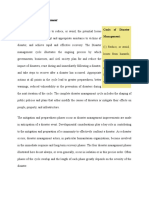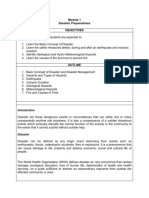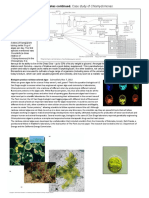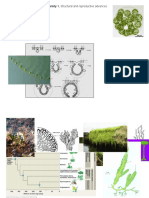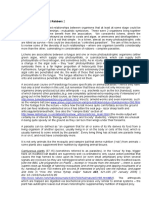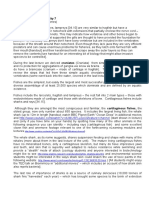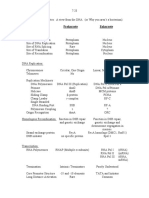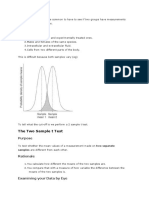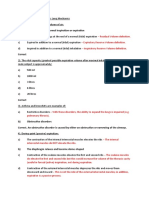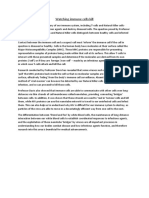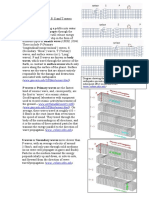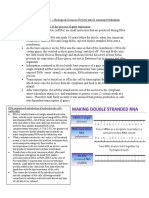The Human Response To Hazards
The Human Response To Hazards
Uploaded by
Richard HampsonCopyright:
Available Formats
The Human Response To Hazards
The Human Response To Hazards
Uploaded by
Richard HampsonOriginal Title
Copyright
Available Formats
Share this document
Did you find this document useful?
Is this content inappropriate?
Copyright:
Available Formats
The Human Response To Hazards
The Human Response To Hazards
Uploaded by
Richard HampsonCopyright:
Available Formats
The Human Response to Hazards
People respond to hazards to try to reduce the risk posed to human life and
possessions. This response can range from an individual level to international level.
Responses chosen (if any – time, resources or knowledge could be lacking) will
depend on:
Type of hazard
Past experience of the hazard
Economic status
Technological resources
Hazard perceptions
Knowledge of the options available
Social and political framework
There are three main responses:
1. Modify the Event – these are management strategies that aim to control the
physical processes ideally by preventing them (unrealistic), controlling the impact
(e.g. alleviating floods by diverting water elsewhere), or by hazard resistant design
(protect people from the impacts).
2. Modify vulnerability – this aims to change people’s attitudes and behaviour
towards hazards by prediction (not always possible or accurate) and warning (so
people can prepare and/or evacuate); community preparedness (public education,
evacuation procedures and emergency relief); and land-use planning (prevent new
development from occupying hazard areas).
3. Modify the loss – people simply accept the losses caused by the hazard (rarely
acceptable, more common to share losses). Losses can be shared through aid for
relief, rehabilitation and reconstruction and through insurance (MEDCs) to
spread the cost.
Useful pages in textbooks:
Topic Natural Hazards Hazards and Responses
Yellow or Green book Red or Pink book
Defining hazards or p.1-6 p. 4 or p.6
Classification or p.8 p. 12 or p.10
Response (general) p. 23 or p. 20
Response to earthquakes Or p.49, 64-70 p. 47 or p.39
Response to volcanoes Or p.74 p. 71 or 62
Response to tsunamis p. 88 or p.74
Response to tropical p. 100 or p.85
cyclones
Response to landslides Or p.86 p. 129 or p.106
Response to avalanches p. 129 or p.107
Response to drought Or p.29 p.115 or p.95
Study skills Or p. 124
Possible questions
Describe in detail one prevention scheme with which you are familiar.
With reference to a range of hazards prevention strategies you have studied,
evaluate their success.
Discuss the ways in which people respond to the threat of hazards and, with
reference to one hazard, explain how and why the response to it may vary.
Discuss the view that it is not possible to prevent hazards but only lessen their
impacts.
People’s responses to hazards are related to levels of economic development.
Examine this statement with reference to two contrasting hazard types.
With reference to a range of hazards, assess the success of prediction
techniques in minimising their impacts on people.
To what extent does hazard perception affect hazard management?
To what extent is the human response to hazards affected by variations in the
economic resources available?
With reference to two contrasting hazard types, examine the extent to which
prediction can reduce their impacts.
Examine the reasons why people respond to hazards in a variety of ways.
Examine how people’s responses are affected by the frequency and
magnitude of natural hazard events.
Examine how people’s responses are affected by the type and location of
natural hazard events.
To what extent do human responses to hazards depend on
research/understanding/frequency/location/economic environment?
You might also like
- Interdisciplinary-Unit-Planner (Math & Science Yr 9)Document11 pagesInterdisciplinary-Unit-Planner (Math & Science Yr 9)Samia AkterNo ratings yet
- DRRMDocument22 pagesDRRMJan herald FernandezNo ratings yet
- Disaster Cycle and PhasesDocument25 pagesDisaster Cycle and PhasesAbhishek WattsNo ratings yet
- Reviewer in NSTPDocument17 pagesReviewer in NSTPNicole Roshelle BumatayNo ratings yet
- Disaster Risk ReductionDocument2 pagesDisaster Risk ReductionJanNo ratings yet
- CutieDocument1 pageCutieKaren NaresNo ratings yet
- Disaster Education Awareness 3Document22 pagesDisaster Education Awareness 3Ejiro OnoroNo ratings yet
- DRRM - Important of DRRMDocument3 pagesDRRM - Important of DRRMAira Clair AlcanoNo ratings yet
- Essay DRR RJDocument1 pageEssay DRR RJGenevieve C. BaelNo ratings yet
- SourcesDocument12 pagesSourcesJoshua ReyesNo ratings yet
- DM PPT 4Document51 pagesDM PPT 4Sarika MadugulaNo ratings yet
- GUIDE QUESTIONS - MODULE 1Document8 pagesGUIDE QUESTIONS - MODULE 1Zoe IsabellaNo ratings yet
- Grade 12 - DRRR - Q2 - Wk6 - GLAKDocument16 pagesGrade 12 - DRRR - Q2 - Wk6 - GLAKJayke Dacuyanan ManaogNo ratings yet
- SCI03 - PPT - CO5 - Disaster Risk Reduction and Management (DRRM) - Concepts, Policies, and ProgramsDocument24 pagesSCI03 - PPT - CO5 - Disaster Risk Reduction and Management (DRRM) - Concepts, Policies, and ProgramsEdward SnowdenNo ratings yet
- Lecture 1 Introduction To Hazards and Disaster Management PDFDocument47 pagesLecture 1 Introduction To Hazards and Disaster Management PDFMazhar AbbasNo ratings yet
- Phases of Disaster Management - 1Document38 pagesPhases of Disaster Management - 1vj11No ratings yet
- Disaster Awareness, Preparedness and ManagementDocument16 pagesDisaster Awareness, Preparedness and ManagementVincent Eucapor100% (1)
- Photo Background Natural DisasterEmergency Response PosterDocument7 pagesPhoto Background Natural DisasterEmergency Response PosterGian Carlo MangulabnanNo ratings yet
- Concept of Disaster Risk ReductionDocument21 pagesConcept of Disaster Risk ReductionJB CarranzaNo ratings yet
- Basic Concepts and Terminologies in Disaster Management: Eld in Feb Adopted From 8 Evrccourse 2009 in BangkokDocument51 pagesBasic Concepts and Terminologies in Disaster Management: Eld in Feb Adopted From 8 Evrccourse 2009 in BangkokJomar Llarenas ZosaNo ratings yet
- CUMALASAG Synthesis On DRR FinalDocument3 pagesCUMALASAG Synthesis On DRR Finalkatecyrelle.cumalasagNo ratings yet
- Disaster Risk Management: Source: UNISDRDocument23 pagesDisaster Risk Management: Source: UNISDRShova ShresthaNo ratings yet
- DRRR Module 1Document69 pagesDRRR Module 1Joveliezel Jaducana Baroro RodriguezNo ratings yet
- Disaster Management Lec-3Document21 pagesDisaster Management Lec-3Naeem100% (1)
- Nirmala Definition of DisasterDocument12 pagesNirmala Definition of DisasterYugandhara Sudhakar Patil100% (1)
- DisasterDocument23 pagesDisasterKatie is juanpitoNo ratings yet
- Understanding DisastersDocument28 pagesUnderstanding DisastersSrijaJuluru100% (1)
- Chapter 4 - Risk Perception and CommunicationDocument36 pagesChapter 4 - Risk Perception and CommunicationSamantha NevisNo ratings yet
- DPPM Unit IDocument9 pagesDPPM Unit IVamshi TangelapallyNo ratings yet
- Prinsip Dasar Manajemen BencanaDocument58 pagesPrinsip Dasar Manajemen BencanaDian Nindita Kusumaningtyas100% (2)
- Arth Thesis With Page NumberDocument25 pagesArth Thesis With Page NumberArtemio Jr A LonzagaNo ratings yet
- Disaster Vulnerability, Risk and Capacity: Md. Inzamul Haque SazalDocument18 pagesDisaster Vulnerability, Risk and Capacity: Md. Inzamul Haque SazaljaslorNo ratings yet
- Disaster Risk Reduction ManagentDocument20 pagesDisaster Risk Reduction ManagentJasmine Ayso SinogayaNo ratings yet
- PM 211 Module 2 - SPDocument11 pagesPM 211 Module 2 - SPLouray JeanNo ratings yet
- NIE Final PlanningDocument60 pagesNIE Final PlanningThan KrisNo ratings yet
- Disaster ManagementDocument12 pagesDisaster ManagementSaroj LamichhaneNo ratings yet
- Nurses Perception Attitude and Practices Regarding Disasters Management and Emergency Preparedness at Sabia General HospDocument7 pagesNurses Perception Attitude and Practices Regarding Disasters Management and Emergency Preparedness at Sabia General HospFahmi HassenNo ratings yet
- Module 1-2-3 Cwts PrelimsDocument10 pagesModule 1-2-3 Cwts PrelimsJosaine TayoneNo ratings yet
- DRRM Manual - Volume I M.D. Pedro, LPTDocument160 pagesDRRM Manual - Volume I M.D. Pedro, LPTLANCE SAYSONNo ratings yet
- 1 Disaster and Disaster Risk Essential LearningDocument4 pages1 Disaster and Disaster Risk Essential Learningrzxd642drhNo ratings yet
- Module 1 D MDocument27 pagesModule 1 D Mannrose.cetNo ratings yet
- ບົດສອນ Msc. Climate Change on Agri-Forest EnvironmentDocument29 pagesບົດສອນ Msc. Climate Change on Agri-Forest Environmentb.donsavanhNo ratings yet
- DRRR 1Document3 pagesDRRR 1Gwen Bess N. CacanindinNo ratings yet
- Disasters Dpac PEDsModule3Document44 pagesDisasters Dpac PEDsModule3faishal azharNo ratings yet
- Unit 1& 2 Disaster MGTDocument32 pagesUnit 1& 2 Disaster MGTAarti SainiNo ratings yet
- SAS 402 Disaster Management Lecture NotesDocument25 pagesSAS 402 Disaster Management Lecture NotesRenee Victor100% (1)
- Disaster Management: Submitted To: Marisha Narula Submitted By: Manvi VaidyaDocument10 pagesDisaster Management: Submitted To: Marisha Narula Submitted By: Manvi VaidyaManvi VaidyaNo ratings yet
- What Is DRRMDocument21 pagesWhat Is DRRMKhim Murillo80% (10)
- Samal Island City College: Learning ModuleDocument52 pagesSamal Island City College: Learning Moduleᜇᜓᜇᜓᜅ᜔ ᜄᜌᜓᜐNo ratings yet
- 4 Infromation and Resources From Government (DRRM Projects and Programs)Document7 pages4 Infromation and Resources From Government (DRRM Projects and Programs)valerie venturaNo ratings yet
- Overviews of Disaster Risk ReductionDocument10 pagesOverviews of Disaster Risk ReductionSaralyn Mawallil AmilhamjaNo ratings yet
- DRR Lesson 6.1Document56 pagesDRR Lesson 6.1Leo EspinoNo ratings yet
- Disater Magmnet NotesDocument63 pagesDisater Magmnet NotesBasit MaqboolNo ratings yet
- Chapter 9 Concept of Disaster Risk Reduction and ManagementDocument26 pagesChapter 9 Concept of Disaster Risk Reduction and ManagementJason B. MaloneNo ratings yet
- DRRR Final TermDocument6 pagesDRRR Final Termmrcrushiee017No ratings yet
- Sustainability 13 00302Document20 pagesSustainability 13 00302yashna.arora.ufpNo ratings yet
- AP 10 - ReviewerDocument5 pagesAP 10 - ReviewerBackuup AccountNo ratings yet
- CWTS 2 Module 1 Disaster PreparednessDocument18 pagesCWTS 2 Module 1 Disaster PreparednessJozel ValenzuelaNo ratings yet
- Lecture 1-Compressed PDFDocument52 pagesLecture 1-Compressed PDFYaqoob Bhatti100% (1)
- Hazard Mitigation and Preparedness An Introductory Text For Emergency Management and Planning Professionals 2nd Schwab Solution ManualDocument9 pagesHazard Mitigation and Preparedness An Introductory Text For Emergency Management and Planning Professionals 2nd Schwab Solution ManualJoe Godinez100% (42)
- Community Emergency Management, Disaster Recovery and ResilienceFrom EverandCommunity Emergency Management, Disaster Recovery and ResilienceNo ratings yet
- Lecture 19 Handout 2013Document2 pagesLecture 19 Handout 2013Richard HampsonNo ratings yet
- Lecture 17 Handout 2013Document2 pagesLecture 17 Handout 2013Richard HampsonNo ratings yet
- Lecture 6 Handout 2013Document2 pagesLecture 6 Handout 2013Richard HampsonNo ratings yet
- Lecture 2 Handout 2013Document3 pagesLecture 2 Handout 2013Richard HampsonNo ratings yet
- Lecture 11 Handout 2013Document2 pagesLecture 11 Handout 2013Richard HampsonNo ratings yet
- Lecture 3 Handout 2013Document2 pagesLecture 3 Handout 2013Richard HampsonNo ratings yet
- Lecture 5 Handout 2013Document2 pagesLecture 5 Handout 2013Richard HampsonNo ratings yet
- Lecture 1 Handout 2013Document4 pagesLecture 1 Handout 2013Richard HampsonNo ratings yet
- Lecture 20 Notes 2013Document4 pagesLecture 20 Notes 2013Richard HampsonNo ratings yet
- Lecture 7 Handout 2013Document2 pagesLecture 7 Handout 2013Richard HampsonNo ratings yet
- Lecture 21 Notes 2013Document3 pagesLecture 21 Notes 2013Richard HampsonNo ratings yet
- Lecture 8 Notes 2013Document3 pagesLecture 8 Notes 2013Richard HampsonNo ratings yet
- Lecture 19 Notes 2013Document4 pagesLecture 19 Notes 2013Richard HampsonNo ratings yet
- Lecture 16 Notes 2013Document4 pagesLecture 16 Notes 2013Richard HampsonNo ratings yet
- Lecture 13 Notes 2013Document4 pagesLecture 13 Notes 2013Richard HampsonNo ratings yet
- Lecture 18 Notes 2013Document4 pagesLecture 18 Notes 2013Richard HampsonNo ratings yet
- Lecture 6 Notes 2013Document4 pagesLecture 6 Notes 2013Richard HampsonNo ratings yet
- Prokaryotes vs. EukaryotesDocument3 pagesProkaryotes vs. EukaryotesRichard HampsonNo ratings yet
- Testing For Differences Between Two GroupsDocument3 pagesTesting For Differences Between Two GroupsRichard HampsonNo ratings yet
- Thaumoctopus Mimicus - The Mimic OctopusDocument4 pagesThaumoctopus Mimicus - The Mimic OctopusRichard HampsonNo ratings yet
- Lab Practical 10 - Human Biology - Lung MechanicsDocument2 pagesLab Practical 10 - Human Biology - Lung MechanicsRichard HampsonNo ratings yet
- Lab Practical 9 - Human Biology - Pulses and Blood PressureDocument2 pagesLab Practical 9 - Human Biology - Pulses and Blood PressureRichard HampsonNo ratings yet
- Watching Immune Cells Kill - Main Points of InterestDocument1 pageWatching Immune Cells Kill - Main Points of InterestRichard HampsonNo ratings yet
- Draft Proposal For Personal Investigation EssayDocument3 pagesDraft Proposal For Personal Investigation EssayRichard HampsonNo ratings yet
- Linear Regression Using The 'Trendline' Function (Excel)Document3 pagesLinear Regression Using The 'Trendline' Function (Excel)Richard HampsonNo ratings yet
- Lab Practical 7 - Switching On Genes - The Lac Operon of E.ColiDocument2 pagesLab Practical 7 - Switching On Genes - The Lac Operon of E.ColiRichard HampsonNo ratings yet
- Unit 4 Exemplar Tectonics - 2010Document8 pagesUnit 4 Exemplar Tectonics - 2010Richard HampsonNo ratings yet
- Global Superpowers - Geography GCSE A-Level InfoDocument3 pagesGlobal Superpowers - Geography GCSE A-Level InfoRichard HampsonNo ratings yet
- Research Task On P, S + T WavesDocument2 pagesResearch Task On P, S + T WavesRichard HampsonNo ratings yet
- Small RNA, Big Impact - BSR Article SummaryDocument3 pagesSmall RNA, Big Impact - BSR Article SummaryRichard HampsonNo ratings yet
- Rajasthan Environment YysbpfDocument108 pagesRajasthan Environment YysbpfPeeyush SharmaNo ratings yet
- Bright gr10 Test 5A - Unit 5Document5 pagesBright gr10 Test 5A - Unit 5Hương Nhiên Trần NgôNo ratings yet
- Education Transformation Framework - Microsoft Education JourneyDocument3 pagesEducation Transformation Framework - Microsoft Education JourneyRefaay SalamaNo ratings yet
- Evaluating Determinants of Tourists' Intentions To Agrotourism in Vietnam Using Value - Belief - Norm TheoryDocument21 pagesEvaluating Determinants of Tourists' Intentions To Agrotourism in Vietnam Using Value - Belief - Norm Theoryngoclancv2023No ratings yet
- JM Ekoton,+Hal+25 34+Halimah+Masloman+Word+2003Document11 pagesJM Ekoton,+Hal+25 34+Halimah+Masloman+Word+2003digatoadsNo ratings yet
- Meta Rubberdam Profoma r1Document23 pagesMeta Rubberdam Profoma r1MR. PRATIK JASWANTENo ratings yet
- Populations in EcosystemsDocument20 pagesPopulations in EcosystemsAaron PostonNo ratings yet
- TEST 2 Grupa: ObesityDocument2 pagesTEST 2 Grupa: ObesitykrkaNo ratings yet
- Cerdomus Catalogo Generale 2022 Low PDFDocument210 pagesCerdomus Catalogo Generale 2022 Low PDFluigi ambricoNo ratings yet
- FRM-OHS-003 Management Review Meeting Minutes TemplateDocument7 pagesFRM-OHS-003 Management Review Meeting Minutes TemplateJoachimNo ratings yet
- Sustainable Development Goal (SDG) Special Symposium - APCChE 2022Document8 pagesSustainable Development Goal (SDG) Special Symposium - APCChE 2022John Larry CorpuzNo ratings yet
- Evs 2Document11 pagesEvs 2rishiomkumarNo ratings yet
- Notes On The Use of BG 6 - 2018 With The RIBA Plan of Work 2020Document1 pageNotes On The Use of BG 6 - 2018 With The RIBA Plan of Work 2020nubazNo ratings yet
- New Price List Brosur Dekkson (April 2022)Document33 pagesNew Price List Brosur Dekkson (April 2022)Deby Rista ManurungNo ratings yet
- Practical Assignment No 1 RaDocument10 pagesPractical Assignment No 1 RaArisha NusratNo ratings yet
- Lampiran 4 Naskah Jurnal InternasionalDocument13 pagesLampiran 4 Naskah Jurnal InternasionalFEBRYANTONo ratings yet
- Solid Waste Management-A Case Study For Hosur-Krishnagiri District, Tamil NaduDocument8 pagesSolid Waste Management-A Case Study For Hosur-Krishnagiri District, Tamil Nadusekarchand33No ratings yet
- Problem and Its ScopeDocument26 pagesProblem and Its ScopeJoesil Dianne SempronNo ratings yet
- PRR Can Dry Up TG Halli Catchment AreaDocument2 pagesPRR Can Dry Up TG Halli Catchment AreaBhaskar ShanmugamNo ratings yet
- Environmental Planning: PUP 442/PUP 598Document8 pagesEnvironmental Planning: PUP 442/PUP 598yaredNo ratings yet
- Microsurfacing 2020Document6 pagesMicrosurfacing 2020TK ThachNo ratings yet
- HHW English Yugantar Rana 12aDocument19 pagesHHW English Yugantar Rana 12azeusNo ratings yet
- Humans On Earth: Diego Díaz Ramírez Colegio Misión Shen R. B. CrawleyDocument8 pagesHumans On Earth: Diego Díaz Ramírez Colegio Misión Shen R. B. CrawleyDiego DíazNo ratings yet
- Appendix B Ecop-Eosh Tot - IntroDocument12 pagesAppendix B Ecop-Eosh Tot - IntroChristian MeanaNo ratings yet
- Choral-Speaking-Environmental-Issues-sk Kampong DachingDocument2 pagesChoral-Speaking-Environmental-Issues-sk Kampong DachingSkada SkkampongdachingNo ratings yet
- Lucy Goes GreenDocument6 pagesLucy Goes GreenrpercorNo ratings yet
- 325-1220-1-PB Analisis Kinerja Jaringan Irigasi Air Tanah (Jiat) Di KabupatenDocument4 pages325-1220-1-PB Analisis Kinerja Jaringan Irigasi Air Tanah (Jiat) Di Kabupatennindya sariNo ratings yet
- LEC 06 - Principles-of-Green-ArchitectureDocument16 pagesLEC 06 - Principles-of-Green-ArchitectureStephen Andrew Joseph SanchezNo ratings yet
- Activity A and BDocument19 pagesActivity A and BZiegfred AlmonteNo ratings yet



































